Africa
To which language should you translate to localize in Morocco?
What we know from our community
“Morocco is a North African nation that borders the Atlantic Ocean and the Mediterranean Sea, with a unique culture due to its Berber, Arabian, and European influences.
Nearly all Moroccans practice Islam, and the vast majority of them are Sunni Muslims who adhere to the Maliki school of Islamic jurisprudence, but the minority religions of Christianity and Judaism are also freely practiced.
The majority of Moroccans are Berber, Arab, or mixed Arab-Berber because of the Berbers making up the majority of the population when Morocco was first settled. The majority of languages are spoken and understood by Moroccans, namely; Moroccan Arabic (Darija), which is technically a dialect of Arabic, and is the most widely used tongue in Morocco. Writing and official communication in Arabic are done in Modern Standard Arabic, also known as “Fossha”. Moreover, there is “Berber” which comprises a collection of mutually exclusive languages used by Berber communities. The French language is widely spoken in Morocco as a result of France’s historical influence there, as it is also the most widely used language in business and government. Spanish is more widely spoken in the north of Morocco, where it is estimated that 5% of the population does so. The English language has recently come under pressure, with initiatives made to prioritize it over French.
On a side note, many French words can be found in the Darija language, so, try not to become confused when Moroccans who speak multiple languages switch between them quickly and without warning.”
Arabic
المغرب دولة تقع في شمال إفريقيا على حدود المحيط الأطلسي والبحر الأبيض المتوسط، وتتمتع بثقافة فريدة بسبب التأثيرات البربرية والعربية والأوروبية.
يعتنق جميع المغاربة تقريبًا الإسلام، حيث أن الغالبية العظمى منهم من المسلمين السنة الذين ينتمون إلى المذهب المالكي للفقه الإسلامي، لكن الأقلية الدينية المسيحية واليهودية تمارس شرائعها أيضًا بحرية.
غالبية المغاربة هم من البربر أو العرب أو مزيج من الاثنين، لأن البربر كانوا يشكلون غالبية السكان عندما تأسيس المغرب. اللغات التي يتحدث بها ويفهمها المغاربة هي: العربية المغربية (الدارجة)، وهي من اللهجات العربية من الناحية الفنية، وهي اللغة أو اللهجة الأكثر استخدامًا في المغرب حيث تتم الكتابة والتواصل الرسمي باللغة العربية الفصحى. علاوة على ذلك، هناك لغة “بربرية” أو “أمازيغية” تضم مجموعة من اللغات التي تستخدمها المجتمعات الأمازيغية. يتم التحدث باللغة الفرنسية على نطاق واسع في المغرب نتيجة للتأثير التاريخي لفرنسا هناك، كما أنها اللغة الأكثر استخدامًا في مجال الأعمال والإدارة. يتم التحدث باللغة الإسبانية على نطاق واسع في شمال المغرب، حيث يقدر أن 5 ٪ من السكان يستطيعون فعل ذلك. سلطت الأضواء مؤخرًا على اللغة الإنجليزية، حيث تم اتخاذ مبادرات لمنحها الأولوية على الفرنسية.
كملاحظة جانبية، يمكن العثور على العديد من الكلمات الفرنسية في اللغة الدارجة، لذا حاول ألا تشعر بالارتباك عندما يتنقل المغاربة الذين يتحدثون لغات متعددة بينها بسرعة ودون سابق إنذار.
Nassim, Interpreter and Translator
What the 150 top websites do
Of the top 150 website (Global by design ranking):
- 48/150 translate into French.
- 34/150 translate into English.
- 10/150 translate into Arabic.
If you need others information, below you can find a selection of economic/social/cultural data
Overview
Language
Morocco is characterized by multilingualism, therefore almost all the Moroccan people speak more than one language.
Official language
Arabic (80%), Berber (60%), French (33%).
Actual languages
Spanish (21%), English (14%).
T-index 0.15%
T-Index ranks countries according to their potential for online sales.
English
Low proficiency (EF) – 76 of 111 countries/regions in the world- 9/20 position in Africa.
Demography
Capitals: Rabat
Currency: The Moroccan Dirham
Population: 38.03 mln
Population density: 85.2/km2
Economy
GDP: 130,91 billion USD (2022)
GDP per capita: 3,527.9 USD (2022)
Exports: 46.7 billion USD (2022)
Statistics
Unemployment rate: 11.8% (2022)
Urbanisation: 65.4% (2024)
Literacy: 77.4% (2024)
Internet users: 90.7% penetration, 34.47 million
Conventions
Numbering system
Arabic numerals with comma as decimal separator.
Date format: dd-mm-yyyy
Time: 24h time system
Country code: 00212
Language data sources: Worldatlas/Britannica//EF/Wikipedia; Demography data sources: IMF/Worldometers; Conventions data source: Wikipedia; Economy data sources: WTO/OEC/CIA/Esomar/Datareportal; Statistics data sources: Datareportal/WorldBank/UN/UNESCO/CEIC/IMF/Culturalatlas/Commisceoglobal
Facts and data
Economy
Imports
68.9 billion USD (2021). Refined Petroleum($8.59B), Wheat ($2.32B), Petroleum Gas ($2.12B), Coal Briquettes ($2.07B), and Cars ($1.98B), importing mostly from Spain ($12.1B), France ($6.7B), China ($6.67B), United States ($4.34B), and Saudi Arabia ($4.18B).
Financial inclusion factors (over 15 years of age)
• 42.2% have an account with a financial
institution
• 1.1% have a credit card
• 6.3% have a mobile money account
• 2% make online purchases
Ease of doing business
It is very easy to conduct business (rated 73.4 out of 100) ranked 3rd out of 20 Northern African and Middle eastern countries and ranked 53 rd out of 190 countries worldwide (2022, World Bank).
Exports
46.7 billion USD (2022). Mixed Mineral or Chemical Fertilizers ($7.06B), Cars ($6.1B), Insulated Wire ($4.21B), Phosphoric Acid ($2.29B), and Calcium Phosphates($1.81B), exporting mostly to Spain ($8.55B), France ($7.92B), India ($2.99B), Italy ($2.2B), and Brazil ($1.96B).
Main local online stores
Avito.ma, Aliexpress.com, Jumia.ma, Ebay, Amazon.
Economic freedom
‘Mostly unfree’ (rated 56.8 out of 100) ranked 14th out of 52 Middle Eastern and Northern African countries and ranked 101st out of 186 countries worldwide
(2024, Heritage Foundation and Wall Street Journal).
Global Innovation Index
Ranked 11th out of 18 Northern African and Western Asian countries, 70 out of 132 worldwide.
The Global Innovation Index captures the innovation
ecosystem performance of 132 economies and tracks the most recent global innovation trends.
Economy data sources: WTO/OEC/CIA/Esomar/Datareportal
Service Imports (2020)
Service Exports (2020)
Source: OEC
Trade balance of goods from 2012 to 2022
Historical Data Trade Imports
The following section uses historical trade data imports from partners of Morocco.
Historical Data Trade Exports
The following section uses historical trade data exports from partners of Morocco.
Source: OEC
The Top Export Opportunities for Morocco by Relatedness
Relatedness measures the distance between a country's current exports and each product by showing only products that Morocco is not specialized in.
Morocco's Most Complex Exports
The Product Complexity Index (PCI) measures the knowledge intensity of a product by considering the knowledge intensity of its exporters.
Source: OEC
Morocco's Most Specialized Products
Specialization is measured using Revealed Comparative Advantage (RCA), an index that takes the ratio between Morocco observed and expected exports in each product.
Source: OEC
Market Growth Imports (2020)
This score represents the likelihood that the given country will start importing that product in the next few years. It forecasts the opening of a new specific market.
Market Growth Exports (2020)
This score represents the likelihood that the given country will start exporting that product in the next few years. It forecasts the opening of a new specific market.
Source: OEC
Foreign direct investment, net inflows (% of GDP)
Source: WorldBank
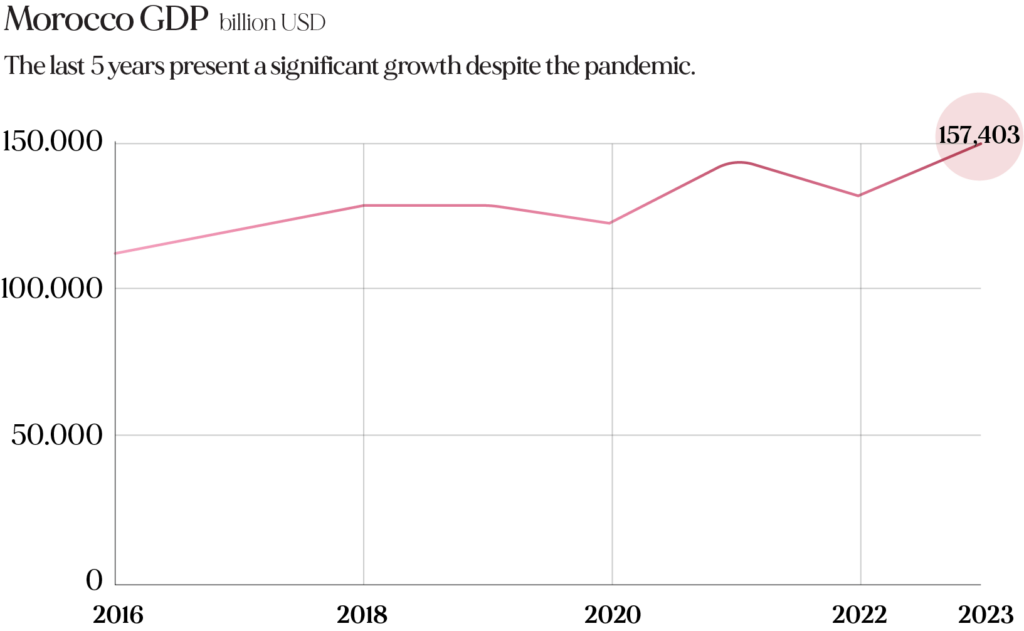

T-index
Reach most of the online purchasing power
T-Index ranks countries according to their potential for online sales. It estimates the market share of each country in relation to global e-commerce.
Try it nowMedia
Media language French, English, Arabic.
Information channels
Media control is concentrated in the hands of the political and business elite. The royal family is an influential stakeholder in an array of media companies, as are a handful of powerful business figures. TV remains Moroccans’ preferred source of information, although this looks set to be overtaken by social media in the near future. The struggling press sector continues to see dwindling sales, and was hit hard by the Covid-19 pandemic. Many of the most influential business-focused publications are in French, but the vast majority of Moroccan news and media is in Arabic, with an increasing prevalence of Darija, the Moroccan Arabic dialect. The state provides some broadcast media in Tamazight, as do several radio stations. The state is re-establishing control of the broadcast sector, buying out the most popular domestic channel 2M in 2021. The large number of media outlets does not equate to a free media environment. Most outlets adhere to the political viewpoints of the government and its close allies. Some criticism of government policies and the economic situation is permitted, but the monarchy and Morocco’s policies in Western Sahara are editorial red lines. A handful of independent, critical outlets remain active, despite intense pressure from the authorities. Their journalists are harassed and in some cases targeted with spyware and imprisoned on spurious charges. Disinformation is prevalent in traditional and online media. Pro-government media outlets are accused of spreading false stories to smear opponents. Networks of pro-government social media accounts have been known to mobilise against government critics.
The press
Le Matin – semi-official daily
Al-Massae – private, daily
Assabah – private, daily
Liberation – private, daily
L’Economiste – business daily
Telquel – private, news weekly
Television
Societe Nationale de Radiodiffusion et de Television (SNRT) – operates state-run Television Marocaine (TVM)
2M – partly state-owned
Al Maghribiya – satellite channel operated by RTM and 2M, aimed at Moroccans living abroad
Medi 1 TV – Tangier-based satellite channel, privately owned by Moroccan and French concerns
Radio
Societe Nationale de Radiodiffusion et de Television (SNRT) – state-run, operates national networks in Arabic, French and regional services
Medi 1 – Tangier-based, privately owned by Moroccan and French concerns, programs in Arabic and French
Aswat Radio – private, FM relays nationally
Hit Radio – private, FM relays nationally
Med Radio – private, FM relays nationally
News Agency
Maghreb Arab Presse (MAP) – state-run, English-language pages
Media data source: BBC
Internet Data
Internet users
90.7% penetration, 34.47 million
Share of web traffic by device
33.96% mobile phones, 65.30% computers (laptops and desktops), 0.72% tablet devices, others 0.01%
Median speed of mobile Internet connection
36.52 Mbps
Median speed of fixed Internet connection
26.43 Mbps
Mobile connection as a percentage of total population
135.1%
Percentage of mobile connections that are broadband (3G-5G)
83.1%
Most popular web search engines
Google (95.35%), Bing (3.13%), Yahoo! (0.98%), YANDEX (0.32%), DuckDuckGo (0.08%), Petal Search (0.04%).
Most used social media
Facebook (59.24%), Youtube (23.8%), Instagram (12.4%), Twitter (2.49%), Pinterest (1.4%), reddit (0.32%).
Internet data sources: Datareportal/Statcounter
Social statistics
Life expectancy
75 yrs (2022)
Current health expenditure
5.74% of GDP (2021)
Current education expenditure
90.7% of total expenditure in public institutions
CO2 emissions
1.8 metric tons per capita
Corruption perceptions Index
Morocco scored 38 out of 100, ranked 94 out of 180 countries worldwide.
World Happiness Index
Morocco ranked 100 out of 146 countries, with a score of 5.060.
Gender
Sexual equality does not exist when it comes to salaries. Women still need to defend this concept and must put up a fight to have their voices heard. In large companies, this is not such an issue and women are treated as equals. Homosexuals are not well regarded and are often marginalised.
Religion
More than 90% of Moroccans are Muslim and the rest are Jewish. There are devout Muslims who never miss a prayer session and females wear veils. There are also non-practising Muslims who drink alcohol and do not strictly follow all the tenants of the religion.
Class
The rich, the poor, and a very small middle class. Social class is very important in Morocco and you will be respected and even feared if you are wealthy or happen to be the son of someone who has a powerful position in the government. Social class can affect the hiring process; it is difficult to not give a good position to someone who comes from an elite family or whose father is mayor of the city. People are often hired through networking and even through covert deals.
Ethnicity
Moroccans living in the centre and north are Arabs while those in the south are Berbers and they speak their own dialect. In order to see the difference between the two types of Arabic, watch the news on television as both Arabic and Berber versions are broadcast. Both ethnic groups are often the topic of jokes and anecdotes.
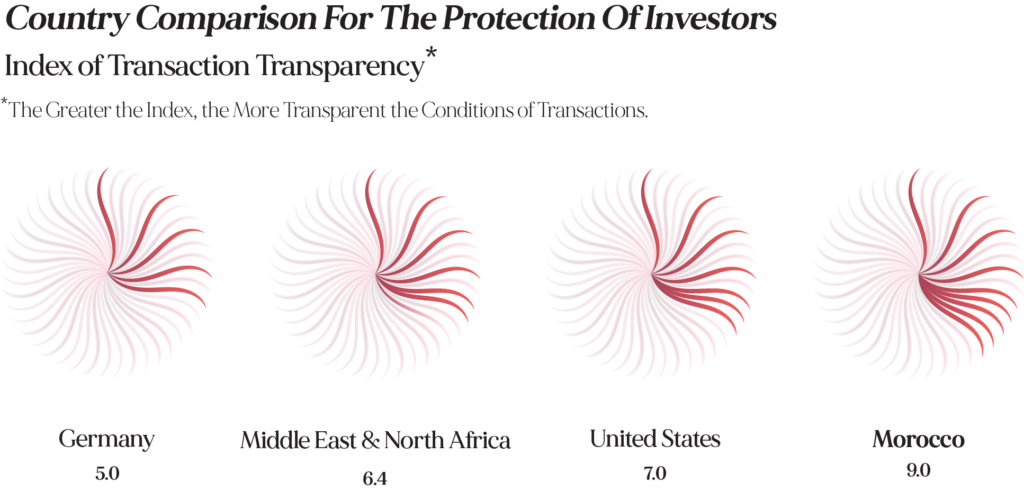
Social statistics sources: WorldBank/UN/UNESCO/CEIC/IMF
The Data Factbook is a work in progress project. Our community is helping us to fill it up always with new and updated data. Your contribution is precious. If you want to help us, please write your advices at imminent@translated.com
Languages research
Languages spoken in Morocco
80
%Arabic
60
%Berber
33
%French
21
%Spanish
Morocco is characterized by multilingualism due to some historical and geographical reasons. Morocco is situated in the northern part of Africa and has been influenced by both African and European countries (especially Spain and France).
Today, the languages spoken in Morocco are Moroccan Arabic, Standard Arabic, Berber, French and Spanish.
Standard Arabic
Even though Standard Arabic (SA) is the official language of Morocco, as well as it is the first language of instruction in public schools, only a few Moroccans speak SA as their first language.
Modern Arabic
Moroccan Arabic (MA) shares the same alphabet as Standard Arabic, with some lexical, morphological, phonetic and syntactic features that differentiate it from SA. Although it is considered the most widely spoken first language of Moroccans, it is not the official language of the country. It is mostly used in informal conversations, as well as social and familiar communication.
Berber
Berber (Tamazight) is the oldest and original language spoken in Morocco. Berber, once reported to receive little respect and considered a language of low prestige, is now gaining more and more authority, by being designated as one of the official languages of Morocco. Schools have recently started the teaching of the Berber language in primary schools. It is also currently experiencing a cultural renaissance in films and literature.
French
Morocco had been under French colonization for 44 years (1912-1956), with the attempt by the French colonizers to modernize the country. Even today, French is considered the most prestigious language in Morocco, as well as the language of science, technology and business.
Spanish
As far as geography is concerned, Spain and Morocco are close and they have influenced each other throughout the years. This can be seen in the presence of the Spanish loan words pelota and cocina (respectively “ball” and “kitchen”) in place of Standard Arabic cura and matbath. Today, Spanish is considered a secondary language spoken mostly in the northern part of the country.
Source: ERIC /Africa News
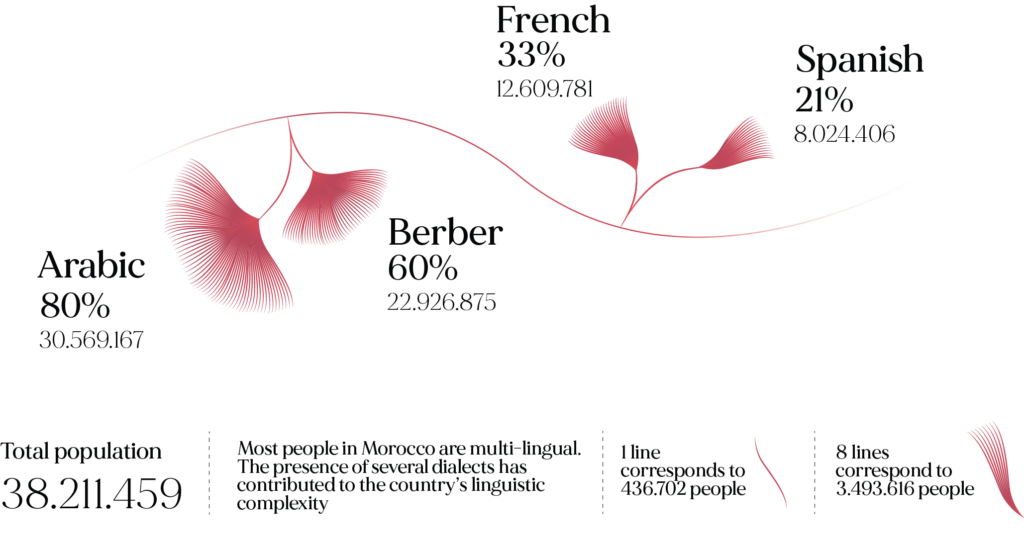
Dialects spoken in Morocco
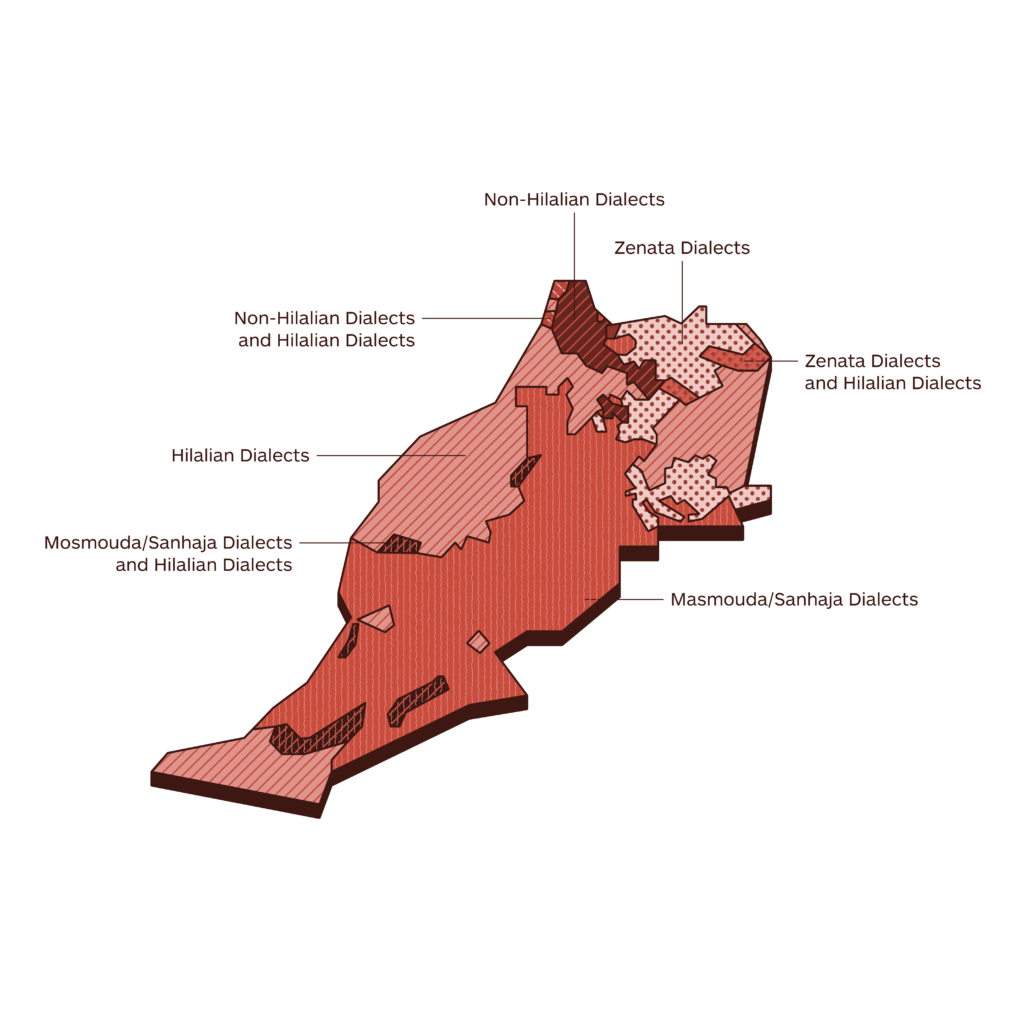
Legend
-
Non-Hilalian Dialects
-
Zenata Dialects
-
Zenata Dialects and Hilalian Dialects
-
Masmouda/Sanhaja Dialects
-
Masmouda/Sanhaja Dialects and Hilalian Dialects
-
Hilalian Dialects
-
Non-Hilalian Dialects and Hilalian Dialects
The geographical distribution of languages that you will find in the maps published in this section is a work in progress. Our community is helping us to fill it up with always new and updated data. Your contribution is precious. If you want to help us, please write to imminent.factbook@translated.com
Photo credit: Heidi Kaden, Unsplash
